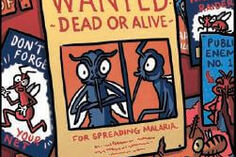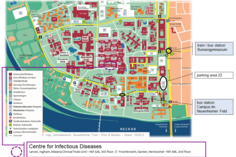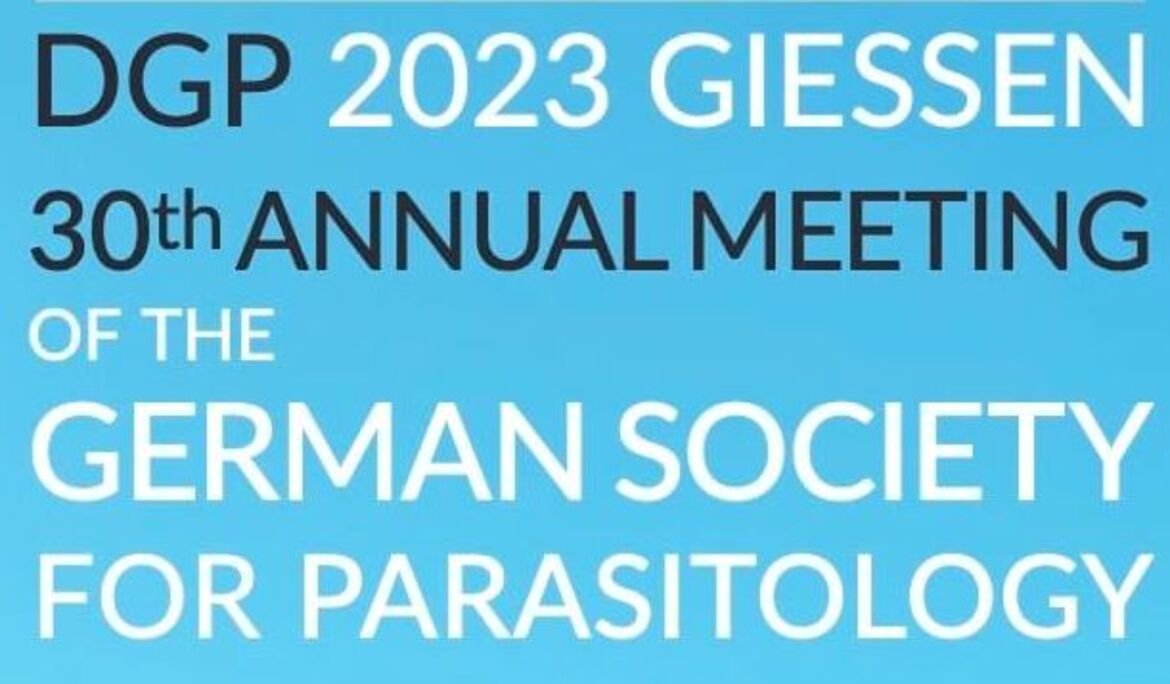
Die AG Lanzer im Detail
Aktuelle Mitarbeiter*innen
Prof. Dr. Michael Lanzer (AG-Leiter, 1999 - aktuell)
Cecilia Sanchez, PhD (Wissenschaftlerin, 1999 - aktuell)
Dr. Guillermo Gómez (Doktorand, 2020 - 2024, seither Postdoc)
Kim Carlstedt (Doktorandin, 2023 - aktuell)
Manar Ewis (Doktorandin, 2024 - aktuell)
Soria Gasparini (Doktorandin, 2023 - aktuell)
Cem Solmaz (MSc-Student, 2025)
Atdhe Kernaja (Biologielaborant)
Marina Müller (MTA)
& wechselnde BSc Studierende :-)
Forschungsschwerpunkt
Die Pathogenität humaner Malaria-Erreger
Die Pionierarbeit von Sir Ronald Ross, der zeigen konnte, dass Malaria eine von Vektoren übertragene Krankheit ist, konnte 1997 ihren 100. Geburtstag feiern. Mehr als 100 Jahre nach dieser Entdeckung ist Malaria immer noch eine der Hauptgeißeln der Menschheit, welche sich für geschätzte 250 Millionen klinischer Fälle und knapp 1 Million Todesfälle jährlich verantwortlich zeigt. Es wird eine Verschlimmerung der Lage erwartet, da einst wirksame Waffen gegen diese infektiöse Krankheit ihre Schlagkraft verloren haben. Chemotherapeutika versagen heutzutage häufig aufgrund der weit verbreiteten Resistenzmechanismen und Insektizide, die einst vielerorts eingesetzt wurden, um die Malaria-Erreger auszulöschen, kommen aufgrund ökologischer Gesichtspunkte nun dafür nicht mehr in Frage. Neue und preisgünstige Medikamente, die für den Masseneinsatz in Entwicklungsländern geeignet wären, sind nicht in Sicht, genauso wenig wie ein weitgehend wirksamer Malaria-Impfstoff. Um dauerhafte Methoden zur Eindämmung der Malaria entwickeln zu können, ist ein besseres Verständnis der ursächlichen Malaria-Erreger, ihrer Biologie, Virulenz und Pathogenität unabdingbar.
Unsere Ziele bestehen genau darin, in der Bestrebung neue Heilmittel zur Behandlung dieser wichtigen Krankheit zu entwickeln. Wir untersuchen vor allem:
- die molekularen Mechanismen der Umgehung der Immunantwort sowie Zytoadhäsion und wie diese pathogenen Mechanismen die Entwicklung der Krankheit beeinflussen;
- die Entwicklung der Chloroquin-Medikamentenresistenz;
- die Mechanismen der Ionen Homeostasis;
- die Anwendung von Ionen-Austauschern als neue Ziele für effektive Medikamenten-Entwicklungsprogramme.
Ausgewählte Publikationen der AG Lanzer
(der letzten 5 Jahre)
Scholz K, Papagrigorakes M, Lettermann L, Pennarola F, Patra P, Dasanna AK, Sanchez CP, Kehrer J, Cavalcanti-Adam EA, Schwarz US, Tanaka M, Lanzer M. Contact Dynamics of Cytoadhering Plasmodium falciparum-Infected Erythrocytes in Flow. ACS Infect Dis. 2025 Aug 10. doi: 10.1021/acsinfecdis.5c00594. Epub ahead of print. PMID: 40783841.
Frangos SM, Damrich S, Gueiber D, Sanchez CP, Wiedemann P, Schwarz US, Hamprecht FA, Lanzer M (2025) Deep learning image analysis for continuous single-cell imaging of dynamic processes in Plasmodium falciparum-infected erythrocytes. Commun Biol. Mar 25;8(1):487. doi: 10.1038/s42003-025-07894-3. PMID: 40133663; PMCID: PMC11937545.
Patra P, Sanchez C, Lanzer M, Schwarz US. (2025) Pair cross-correlation analysis for assessing protein co-localization. Biophys J. 2025 Mar 11:S0006-3495(25)00138-9. doi: 10.1016/j.bpj.2025.03.002. Epub ahead of print. PMID: 40077967.
Rathay V, Fürle K, Kiehl V, Ulmer A, Lanzer M, Thomson-Luque R. (2024) IgG Subclass Switch in Volunteers Repeatedly Immunized with the Full-Length Plasmodium falciparum Merozoite Surface Protein 1 (MSP1). Vaccines. 12(2):208. https://doi.org/10.3390/vaccines12020208
Alder A, Sanchez CP, Russell MRG, Collinson LM, Lanzer M, Blackman MJ, Gilberger TW, Matz JM (2023) The role of Plasmodium V-ATPase in vacuolar physiology and antimalarial drug uptake. Proc Natl Acad Sci U S A. Jul 25;120(30):e2306420120. doi: 10.1073/pnas.2306420120. Epub 2023 Jul 18. PMID: 37463201; PMCID: PMC10372686.
Rosenkranz M, Fürle K, Hibbert J, Ulmer A, Ali A, Giese T, Blank A, Haefeli WE, Böhnlein E, Lanzer M, Thomson-Luque R (2023) Multifunctional IgG/IgM antibodies and cellular cytotoxicity are elicited by the full-length MSP1 SumayaVac-1 malaria vaccine. NPJ Vaccines. Aug 9;8(1):112. doi: 10.1038/s41541-023-00701-2. PMID: 37558673; PMCID: PMC10412566.
Berger F, Gomez GM, Sanchez CP, Posch B, Planelles G, Sohraby F, Nunes-Alves A, Lanzer M (2023) pH-dependence of the Plasmodium falciparum chloroquine resistance transporter is linked to the transport cycle. Nat Commun. Jul 15;14(1):4234. doi: 10.1038/s41467-023-39969-2. PMID: 37454114; PMCID: PMC10349806.
Gomez GM, D'Arrigo G, Sanchez CP, Berger F, Wade RC, Lanzer M (2023) PfCRT mutations conferring piperaquine resistance in falciparum malaria shape the kinetics of quinoline drug binding and transport. PLoS Pathog. Jun 7;19(6):e1011436. doi: 10.1371/journal.ppat.1011436. PMID: 37285379; PMCID: PMC10281575.
Haag M, Kehrer J, Sanchez CP, Deponte M, Lanzer M (2022) Physiological jump in erythrocyte redox potential during Plasmodium falciparum development occurs independent of the sickle cell trait. Redox Biol. Nov 10;58:102536. doi: 10.1016/j.redox.2022.102536. Epub ahead of print. PMID: 36401887; PMCID: PMC9673094.
Tanaka M, Lanzer M (2022) Receptor-Functionalized Lipid Membranes as Biomimetic Surfaces for Adhesion of Plasmodium falciparum-Infected Erythrocytes. Methods Mol Biol. 2470:601-613. doi: 10.1007/978-1-0716-2189-9_45. PMID: 35881377.
Karathanasis C, Sanchez CP, Heilemann M, Lanzer M (2022) Assessing Antigen Presentation on the Surface of Plasmodium falciparum-Infected Erythrocytes by Photoactivated Localization Microscopy (PALM). Methods Mol Biol. 2470:457-466. doi: 10.1007/978-1-0716-2189-9_34. PMID: 35881366.
Cyrklaff M, Sanchez CP, Hanebutte L, Jäger J, Schwarz US, Lanzer M (2022) An Improved Method for Assessing Antigen Presentation on the Surface of Plasmodium falciparum-Infected Erythrocytes by Immuno-Electron Microscopy. Methods Mol Biol. 2470:445-455. doi: 10.1007/978-1-0716-2189-9_33. PMID: 35881365.
Sanchez CP, Manson EDT, Moliner Cubel S, Mandel L, Weidt SK, Barrett MP, Lanzer M (2022) The Knock-Down of the Chloroquine Resistance Transporter PfCRT Is Linked to Oligopeptide Handling in Plasmodium falciparum. Microbiol Spectr. Aug 31;10(4):e0110122. doi: 10.1128/spectrum.01101-22. Epub 2022 Jul 18. PMID: 35867395; PMCID: PMC9431119.
Wai CH, Jin J, Cyrklaff M, Genoud C, Funaya C, Sattler J, Maceski A, Meier S, Heiland S, Lanzer M, Frischknecht F, Kuhle J, Bendszus M, Hoffmann A (2022) Neurofilament light chain plasma levels are associated with area of brain damage in experimental cerebral malaria. Sci Rep. Jun 24;12(1):10726. doi: 10.1038/s41598-022-14291-x. PMID: 35750882; PMCID: PMC9232608.
Jäger J, Patra P, Sanchez CP, Lanzer M, Schwarz US (2022) A particle-based computational model to analyse remodelling of the red blood cell cytoskeleton during malaria infections. PLoS Comput Biol. Apr 8;18(4):e1009509. doi: 10.1371/journal.pcbi.1009509. PMID: 35394995.
Jin J, Ba MA, Wai CH, Mohanty S, Sahu PK, Pattnaik R, Pirpamer L, Fischer M, Heiland S, Lanzer M, Frischknecht F, Mueller AK, Pfeil J, Majhi M, Cyrklaff M, Wassmer SC, Bendszus M, Hoffmann A (2022) Transcellular blood-brain barrier disruption in malaria-induced reversible brain edema. Life Sci Alliance. Mar 8;5(6):e202201402. doi: 10.26508/lsa.202201402. PMID: 35260473; PMCID: PMC8905774.
Sanchez CP, Patra P, Chang SS, Karathanasis C, Hanebutte L, Kilian N, Cyrklaff M, Heilemann M, Schwarz US, Kudryashev M, Lanzer M (2022) KAHRP dynamically relocalizes to remodeled actin junctions and associates with knob spirals in Plasmodium falciparum-infected erythrocytes. Mol Microbiol. Feb;117(2):274-292. doi: 10.1111/mmi.14811. Epub 2021 Sep 22. PMID: 34514656.
Dijkman PM, Marzluf T, Zhang Y, Chang SS, Helm D, Lanzer M, Bujard H, Kudryashev M (2021) Structure of the merozoite surface protein 1 from Plasmodium falciparum. Sci Adv. Jun 2;7(23):eabg0465.
Fröhlich B, Dasanna AK, Lansche C, Czajor J, Sanchez CP, Cyrklaff M, Yamamoto A, Craig A, Schwarz US, Lanzer M, Tanaka M (2021) Functionalized supported membranes for quantifying adhesion of P. falciparum-infected erythrocytes. Biophys J. Jul 8:S0006-3495(21)00552-X
Bukau B, Lanzer M, Melchers F, Wallon G (2020) Hermann Bujard (1934 - 2020) - pioneering researcher and visionary science politician. EMBO J. Dec 1;39(23):e106981
Frohlich B, Yang Y, Thoma J, Czajor J, Lansche C, Sanchez C, Lanzer M, Cloetens P, Tanaka M (2020) Nanofocused Scanning X-ray Fluorescence Microscopy Revealing an Effect of Heterozygous Hemoglobin S and C on Biochemical Activities in Plasmodium falciparum-Infected Erythrocytes. Anal Chem 92: 5765-5771
Blank A, Furle K, Jaschke A, Mikus G, Lehmann M, Husing J, Heiss K, Giese T, Carter D, Bohnlein E, Lanzer M, Haefeli WE, Bujard H (2020) Immunization with full-length Plasmodium falciparum merozoite surface protein 1 is safe and elicits functional cytophilic antibodies in a randomized first-in-human trial. NPJ Vaccines 5: 10
News - AG Lanzer
DGP Konferenz in Gießen (15.-17. März 2023)
Vom 15. bis 17. März 2023 war die Welt der Parasitologie zu Gast in Gießen, genauer gesagt an der Justus Liebig-Universität (JLU), die die diesjährige Jahrestagung der Deutschen Gesellschaft für Parasitologie (DGP) ausrichtete.
Die dreitägige Veranstaltung bot nicht nur Hauptvorträge von renommierten Wissenschaftlern aus der ganzen Welt, sondern auch viele Beiträge von aktuellen und ehemaligen Mitgliedern der Abt. Parasitologie hier in Heidelberg. Neben den Vorträgen unserer Gruppenleiter Freddy Frischknecht und Julien Guizetti kamen die Teilnehmer in den Genuss von Präsentationen von Aiste Kudulyte (MSc Studentin in der AG Ganter und ab April Doktorandin) und Yvonne Sokolowski (Studentin in der AG Frischknecht). Mehrere ehemalige Gruppenleiter unserer Abteilung gaben Einblicke in ihre aktuelle Forschung (Marcel Deponte, Kai Matuschewski und Markus Meissner) und unsere Doktorandin Monami Roy Chowdhury (AG Frischknecht) gewann den ersten Posterpreis. Zu guter letzt wurde die ehemalige Doktorandin der AG Ganter, Severina Klaus, mit dem Piekarski-Preis für ihre Dissertation im Jahr 2022 ausgezeichnet und unser Abteilungsleiter Michael Lanzer wurde mit der Rudolf-Leuckart-Medaille für seine herausragenden Verdienste um die Förderung der Parasitologie geehrt.

Postdoc or PhD student position
We are seeking a highly motivated Postdoctoral Fellow or PhD candidate to join our research on the Plasmodium falciparum chloroquine resistance transporter (PfCRT) – a key determinant of antimalarial drug resistance. The project aims to unravel PfCRT’s transport cycle and structure–function relationships using site-directed mutagenesis and functional assays in Xenopus laevis oocytes, complemented by molecular dynamics simulations.
Candidates must have documented experience with the Xenopus laevis oocyte system and a strong interest in membrane transport biology. The position is fully funded by the German Research Foundation (DFG), with salary according to TV-L E13.
Applications to be submitted via our Graduate School's online system.
Start of the position: as soon as possible
Kontaktdaten:
Prof. Dr. rer. nat. Michael Lanzer
Ärztlicher Direktor
Arbeitsgruppenleiter
C4-Professor für Parasitologie






